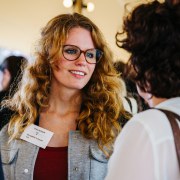Evaluating the impact of sensitive and intangible stories
Conservation of nature, life and death and the time span of human evolution - three different exhibition topics that are hard to display, yet what impact do they actually have? Exhibition makers use a vast amount of resources and choose different techniques to tackle hard to grasp, very sensitive or particularly relevant topics but it is hard to measure any success when research on their impact is limited.
In this session, three speakers share what impact their approaches had on visitors using summative evaluations and provide a general perspective on the lessons learned from impact evaluation. Come and discuss how institutions can benefit from evaluation to find out which techniques work best when exhibiting sensitive or demanding topics in the future, helping us to make progress.
Facilitator
PhD-Researcher & Lecturer Media Studies | Mediatised Experiences in Heritage
Amsterdam University of Applied Sciences
Session speakers
Director of contents and science engagement
In 2019 we decided to renovate the "Aquarium" exhibition shifting the message to conservation. During the renovation, our team had unanswered questions. For example, what would be the ideal scripts to get people to understand the environmental issue if it is known that information does not change perceptions? In this panel I will discuss our evaluation results that show us if the conservation message is perceived and if visitors are willing to change attitudes. I will present what it means for planning exhibitions on environmental issues.
Jana talks about a DASA project that evaluates the impact of storytelling in the temporary exhibition “Pia says Goodbye. An Exhibition on the Work with Death and Grief”. This case study applies a mixed methods approach (interviews and observations) to assess visitor behaviour and perceptions. A key question is what visitors take away from a strong exhibition narrative. Does the story help to dig into this difficult topic? The focus on evaluating the impact of an exhibition narrative is an innovative approach and Jana discusses the first results and challenges.
Scientific Staff - Exhibition Curator
Stiftung Deutsches Fußballmuseum
In 2016 the Neanderthal Museum did an update on parts of the permanent exhibition. In the exhibition area “A journey through time” we combined hyperrealistic reconstructions of Hominins with personal storytelling, touchable exhibits and classic elements like showcases to show human evolution over the last 7 million years. By doing an evaluation study with mixed methods (observations and interviews) we are trying to find out if and how our visitors perceive something that is so abstract and hard to grasp like long time spans and the everlasting evolutionary process.
Project and Exhibition Manager
Bernadette focuses on the question: What can we do with all the knowledge and results from impact evaluation?
Based on examples of several exhibition evaluations in her own work she gives a more general overview on evaluation processes and what an institution can learn for next projects.
Using different methods and evaluating intangible themes cause different outcomes. An important goal in an evaluation process are the lessons learned: They give relevant input to other projects. Which outcomes are relevant? How do we know? What are we doing with them? How can we generalize? Bernadette will give insight in working with the challenges of structuring the knowledge we get out of evaluation projects.





